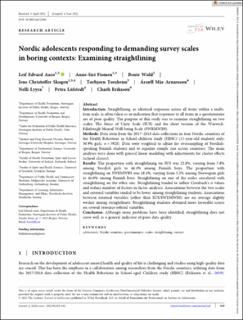| dc.contributor.author | Aarø, Leif Edvard | |
| dc.contributor.author | Fismen, Anne-Siri | |
| dc.contributor.author | Wold, Bente | |
| dc.contributor.author | Skogen, Jens Christoffer | |
| dc.contributor.author | Torsheim, Torbjørn | |
| dc.contributor.author | Már Arnarsson, Ársæll | |
| dc.contributor.author | Lyyra, Nelli | |
| dc.contributor.author | Löfstedt, Petra | |
| dc.contributor.author | Eriksson, Charli | |
| dc.date.accessioned | 2022-12-23T08:15:57Z | |
| dc.date.available | 2022-12-23T08:15:57Z | |
| dc.date.created | 2022-09-06T10:57:27Z | |
| dc.date.issued | 2022 | |
| dc.identifier.issn | 0140-1971 | |
| dc.identifier.uri | https://hdl.handle.net/11250/3039308 | |
| dc.description.abstract | Introduction
Straightlining, or identical responses across all items within a multi-item scale, is often taken as an indication that responses to all items in a questionnaire are of poor quality. The purpose of this study was to examine straightlining on two scales: The Sense of Unity Scale (SUS) and the short version of the Warwick-Edinburgh Mental Well-being Scale (SWEMWBS).
Methods
Data stem from the 2017–2018 data collections in four Nordic countries of the Health Behaviour in School-children study (HBSC) (15-year-old students only; 50.9% girls; n = 5928). Data were weighted to adjust for oversampling of Swedish-speaking Finnish students and to equalize sample size across countries. The main analyses were done with general linear modeling with adjustments for cluster effects (school classes).
Results
The proportion with straightlining on SUS was 22.8%, varying from 5.8% among Swedish girls to 46.4% among Finnish boys. The proportion with straightlining on SWEMWBS was 18.4%, varying from 5.2% among Norwegian girls to 46.0% among Finnish boys. Straightlining on one of the scales correlated with straightlining on the other one. Straightlining tended to inflate Cronbach's α values and reduce number of factors in factor analyses. Associations between the two scales and external variables tended to be lower among straightlining students. Associations between external variables (other than SUS/SWEMWBS) are on average slightly weaker among straightliners. Straightlining students obtained more favorable scores on several resource-related variables.
Conclusion
Although some problems have been identified, straightlining does not serve well as a general indicator of poor data quality. | en_US |
| dc.language.iso | eng | en_US |
| dc.publisher | Wiley | en_US |
| dc.rights | Attribution-NonCommercial-NoDerivatives 4.0 Internasjonal | * |
| dc.rights.uri | http://creativecommons.org/licenses/by-nc-nd/4.0/deed.no | * |
| dc.title | Nordic adolescents responding to demanding survey scales in boring contexts: Examining straightlining | en_US |
| dc.type | Journal article | en_US |
| dc.type | Peer reviewed | en_US |
| dc.description.version | publishedVersion | en_US |
| dc.rights.holder | Copyright 2022 The Author(s) | en_US |
| cristin.ispublished | true | |
| cristin.fulltext | original | |
| cristin.qualitycode | 1 | |
| dc.identifier.doi | 10.1002/jad.12066 | |
| dc.identifier.cristin | 2049137 | |
| dc.source.journal | Journal of Adolescence | en_US |
| dc.source.pagenumber | 829-843 | en_US |
| dc.relation.project | EC/H2020/774210 | en_US |
| dc.identifier.citation | Journal of Adolescence. 2022, 94 (6), 829-843. | en_US |
| dc.source.volume | 94 | en_US |
| dc.source.issue | 6 | en_US |

